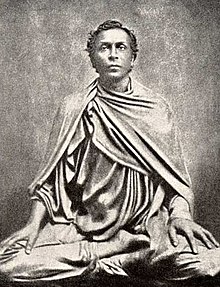

This article includes a list of references, related reading, or external links, but its sources remain unclear because it lacks inline citations. Please help improve this article by introducing more precise citations. (February 2024) (Learn how and when to remove this message)
|
| People of the Pāli Canon | ||||||||||||||||||||||||||||||||
|---|---|---|---|---|---|---|---|---|---|---|---|---|---|---|---|---|---|---|---|---|---|---|---|---|---|---|---|---|---|---|---|---|
|
||||||||||||||||||||||||||||||||
|
| ||||||||||||||||||||||||||||||||

InBuddhism, an anagārika (Pali, 'homeless one', [əˈnəɡɑːrɪkə]; f. anagārikā [əˈnəɡɑːrɪkɑː]) is a person who has given up most or all of their worldly possessions and responsibilities to commit full-time to Buddhist practice. It is a midway status between a bhikkhuorbhikkhuni (fully ordained monastics) and laypersons. An anagārika takes the Eight Precepts, and might remain in this state for life.
Anagārikas usually wear white clothes or robes, depending on the tradition they follow. Some traditions have special ordination ceremonies for anagārikas, while others simply take the eight precepts with a special intention.
Given the lack of full ordination for women in most Theravada-majority countries since the late modern period, women who wish to renounce live as anagārikās under names such as maechiinThailand, thilashininMyanmar, and dasa sil matainSri Lanka. Women who are nonetheless intent on total renunciation may be fully ordained under certain nikāyas, even in historically Theravada countries. In Vajrayana Buddhism, many nuns are technically anagārikās or śrāmaṇerikās (novitiates).
In monastic settings, lay attendants for monks or nuns are needed. The monastic rules restrict monks and nuns from many tasks that might be needed, including the use of money, driving, cooking, digging and cutting plants, so lay attendants help bridge this gap. Anagārikas differ from laity by their commitment to Buddhism, to their precepts, and to monastics. There is usually a notable difference in their manner, appearance and attire. In many cases, they are full-time residents at the vihara where they ordained. Anagārikas often have the intention of becoming a monk or nun at a later point, though not always. In some monasteries a period as an anagārika, often one year, is required in order to take novice ordination.
The main difference between the Eight Precepts of an anagārika and the Ten Precepts of a novitiate is the rule of not handling money. Therefore, anagārika ordinations usually take place in viharas where the vinaya (monastic rules), including the rules about not handling money, are strictly followed.
This Buddhism-related article is a stub. You can help Wikipedia by expanding it. |